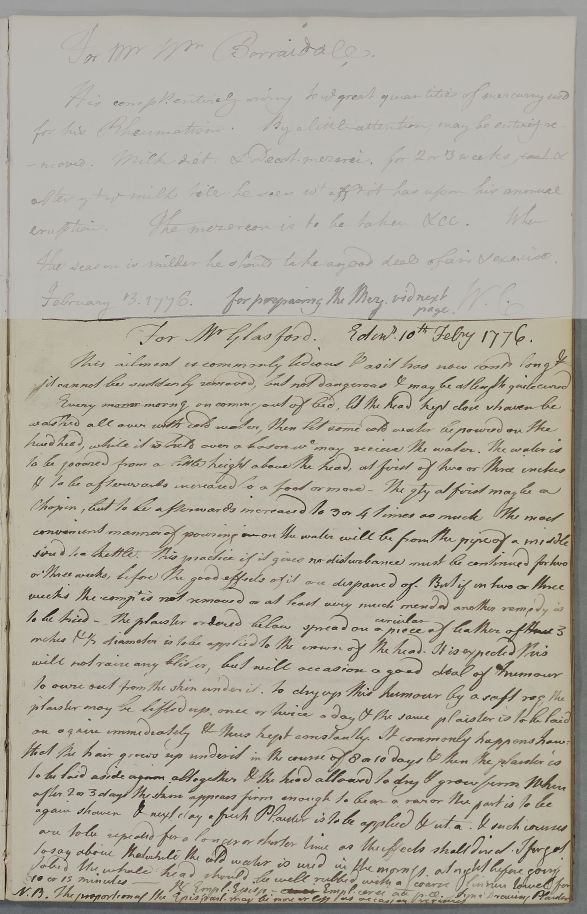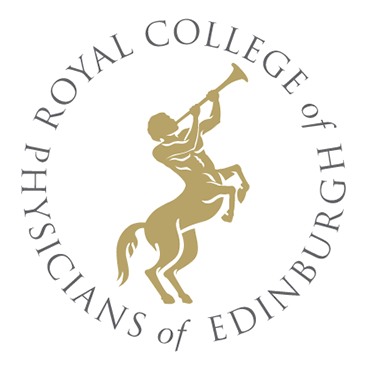
The Consultation Letters of Dr William Cullen (1710-1790) at the Royal College of Physicians of Edinburgh
[ID:383] From: Dr William Cullen (Professor Cullen) / To: Dr Alexander Stevenson (Professor; of Dalgairn ) / Regarding: Mr John Glassford (of Dougalston) (Patient) / 10 February 1776 / (Outgoing)
Reply 'For Mr Glasford'. His condition is 'commonly tedious' but not dangerous. It is probably intended for Alexander Stevenson, who attends other members of the Glassford family.
- Facsimile
- Normalized Text
- Diplomatic Text
- Metadata
- Case
- People
- Places
Facsimile
There is 1 image for this document.

[Page 1]
Metadata
| Field | Data |
|---|---|
| DOC ID | 383 |
| RCPE Catalogue Number | CUL/1/1/6/82 |
| Main Language | English |
| Document Direction | Outgoing |
| Date | 10 February 1776 |
| Annotation | None |
| Type | Scribal copy ( includes Casebook Entry) |
| Enclosure(s) | No enclosure(s) |
| Autopsy | No |
| Recipe | Yes |
| Regimen | No |
| Letter of Introduction | No |
| Case Note | No |
| Summary | Reply 'For Mr Glasford'. His condition is 'commonly tedious' but not dangerous. It is probably intended for Alexander Stevenson, who attends other members of the Glassford family. |
| Manuscript Incomplete? | No |
| Evidence of Commercial Posting | No |
Case
Cases that this document belongs to:
| Case ID | Description | Num Docs |
|---|---|---|
| [Case ID:330] |
Case of John Glassford, the 'Tobacco Lord' who suffers from a long-term stomach complaint which eventually proves fatal. Includes post-mortem report. Internal reference implies he was Cullen's patient in 1768, though no letters are extant. |
11 |
People linked to this document
| Person ID | Role in document | Person |
|---|---|---|
| [PERS ID:1] | Author | Dr William Cullen (Professor Cullen) |
| [PERS ID:563] | Addressee | Dr Alexander Stevenson (Professor; of Dalgairn ) |
| [PERS ID:1619] | Patient | Mr John Glassford (of Dougalston) |
| [PERS ID:1] | Patient's Physician / Surgeon / Apothecary | Dr William Cullen (Professor Cullen) |
| [PERS ID:563] | Patient's Physician / Surgeon / Apothecary | Dr Alexander Stevenson (Professor; of Dalgairn ) |
Places linked to this document
| Role in document | Specific Place | Settlements / Areas | Region | Country | Global Region | Confidence |
|---|---|---|---|---|---|---|
| Place of Writing | Cullen's House / Mint Close | Edinburgh | Edinburgh and East | Scotland | Europe | certain |
| Destination of Letter | Glasgow | Glasgow and West | Scotland | Europe | inferred |
Normalized Text
For Mr Glasford.
This ailment is commonly tedious & as it has now continued long &
it cannot be suddenly removed, but not dangerous & may be at length quite cured.
Every monn morning on coming out of bed, let the head kept close shaven be
washed all over with cold water, then let some cold water be poured on the
hind head, while it is held over a bason which may receive the water. The water is
to be poured from a little height above the head, at first of two or three inches
& to be afterwards increased to a foot or more – The quantity at first may be a
Chopin, but to be afterwards increased to 3 or 4 times as much The most
convenient manner of pouring in on the water will be from the pipe of a middle
sized tea kettle. This practice if it gives no disturbance must be continued for two
or three weeks, before the good effects of it are despaired of. But if in two or three
weeks the complaint is not removed or at least very much mended another remedy is
to be tried - The plaister ordered below spread on a ↑circular↑ piece of leather of three 3
inches & [¼?] diameter is to be applied to the crown of the head. It is expected this
will not raise any blister, but will occasion a good deal of humour
to ouze out from the skin under it. To dry up this humour by a soft rag, the
plaister may be lifted up once or twice a day & the same plaister is to be laid
on again immediately & thus kept constantly. It commonly happens however
that the hair grows up under it in the course of 8 or 10 days & then the plaister is
to be laid aside again altogether & the head allowed to dry & grow firm when
after 2 or 3 days the skin appears firm enough to bear a razor the part is to be
again shaven & next day a fresh Plaister is to be applied & ut. a. & such courses
are to be repeated for a longer or shorter time as the effects shall direct. I forgot
to say above that while the cold water is used in the mornings at night before going
to bed his whole head should be well rubbed with a coarse linnen towel for
10 to 15 minutes ----
Take half a [scruple?] each of Epispastic and Wax Pastes. Label: Drawing Plaister N.B. The proportion of the Epispastic may be more or less as occasion requires
Diplomatic Text
For Mr Glasford.
This ailment is commonly tedious & as it has now contd long &
it cannot be suddenly removed, but not dangerous & may be at length quite cured.
Every monn morng on coming out of bed, let the head kept close shaven be
washed all over with cold water, then let some cold water be poured on the
hind head, while it is held over a bason wc may receive the water. The water is
to be poured from a little height above the head, at first of two or three inches
& to be afterwards increased to a foot or more – The qty at first may be a
Chopin, but to be afterwards increased to 3 or 4 times as much The most
convenient manner of pouring in on the water will be from the pipe of a middle
sized tea kettle. This practice if it gives no disturbance must be continued for two
or three weeks, before the good effects of it are despaired of. But if in two or three
weeks the compt is not removed or at least very much mended another remedy is
to be tried - The plaister ordered below spread on a ↑circular↑ piece of leather of three 3
inches & [¼?] diameter is to be applied to the crown of the head. It is expected this
will not raise any blister, but will occasion a good deal of humour
to ouze out from the skin under it. To dry up this humour by a soft rag, the
plaister may be lifted up once or twice a day & the same plaister is to be laid
on again immediately & thus kept constantly. It commonly happens how:
that the hair grows up under it in the course of 8 or 10 days & then the plaister is
to be laid aside again altogether & the head allowed to dry & grow firm when
after 2 or 3 days the skin appears firm enough to bear a razor the part is to be
again shaven & next day a fresh Plaister is to be applied & ut. a. & such courses
are to be repeated for a longer or shorter time as the effects shall direct. I forgot
to say above that while the cold water is used in the morngs. at night before going
to bed his whole head should be well rubbed with a coarse linnen towel for
10 to 15 minutes ----
℞ Empl. Episp. – cerei Empl. cerei @ ſs.[℈?]. Signa Drawing Plaister
N.B. The proportion of the Epispast. may be more or less as occasion requires
XML
XML file not yet available.
Feedback
Send us specfic feeback about this document [DOC ID:383]
Please note that the Cullen Project team have now disbanded but your comments will be logged in our system and we will look at them one day...


